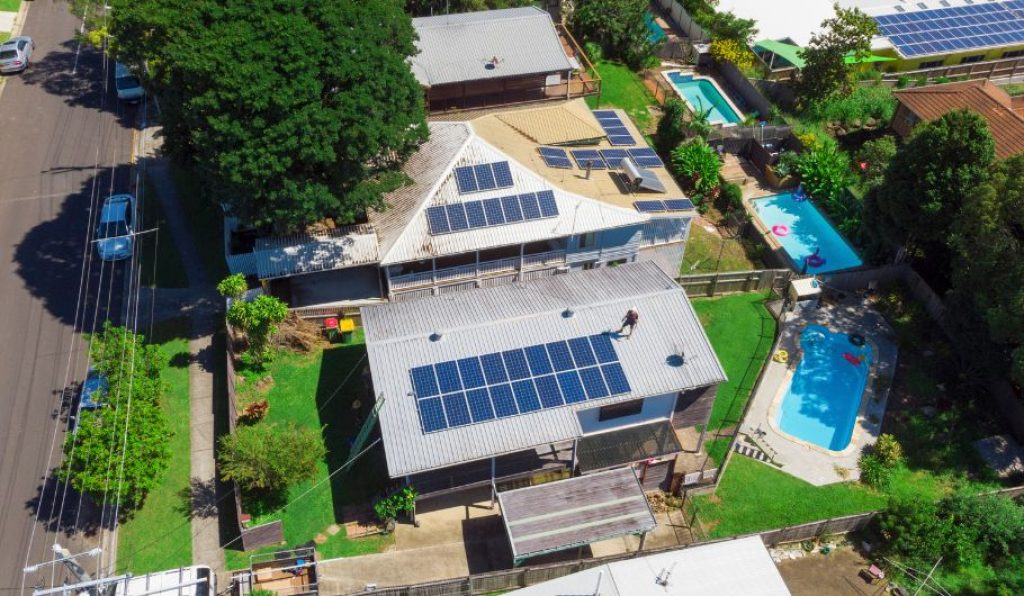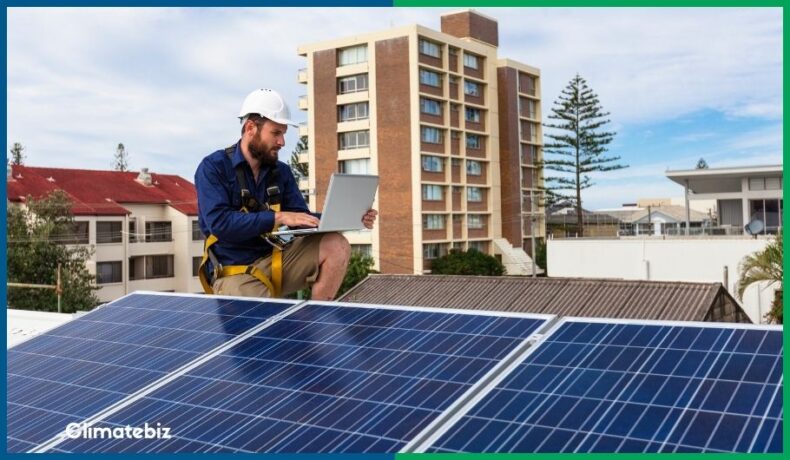In 2021, a new solar panel project was initiated every 60 seconds; it’s predicted that by 2030 over 13% of U.S. homes will have a residential solar system installed.
With over 140 million homes in the U.S., this equates to 18,200,000 homeowners installing solar systems. So if you thought you were the only one wondering whether solar panels are worth it, you’d be wrong.
In this report, we look at the factors that influence the viability of solar panel installation. We also provide real-world working examples that you can use to help you determine whether solar panels are worth installing in your area.
Table of Contents
When Is Installing Solar Panels Worth It?
There are many ways homeowners can determine whether solar panels are worth installing. A few deciding factors include:
- Home location,
- Electricity bill,
- Solar tax incentives, and
- Return on investment duration.
Why Home Location Is Important
Solar panels require sunlight or solar irradiance to produce electricity through what’s known as the photovoltaic effect.
As you may know, different regions experience varying climatic conditions, affecting the amount of sunshine you receive.
If your home is located in an area that doesn’t receive much sunlight, your solar panels will struggle to produce significant amounts of electricity.
Why Electricity Bill Is Important
The right-sized solar system can offset your home’s energy consumption by 95% (or more) — the more money you spend on your electricity bill, the more money you aim to save every month.
However, low monthly electricity bills mean that your overall yearly solar savings may not justify the high upfront installation cost.
Federal Solar Tax Credits
“The federal residential solar incentive is a tax credit that you can claim on federal income taxes for a percentage of the cost of a solar photovoltaic (PV) system.” – U.S. Department of Energy.
Those percentages look as follows:
- 2020 – 2021, 26%
- 2022 – 2032, 30%
- 2033, 26%
- 2034, 22%
- 2035 – Set to expire (unless renewed)
Payback Period
It would be best to consider your payback period while establishing whether solar panel installation is worth it because it considers both the above points.
Two homeowners who consume the same amount of electricity will not experience the same payback period if they live in different locations.
If you live in an area that experiences less solar irradiance, you may need to consider buying a more extensive solar system to offset your energy consumption; this will result in higher upfront costs and, thus, an extended payback period.

How Much Do Solar Panels Cost?
According to this technical report by NREL, residential rooftop solar systems sized between 3 – 11 kW generally cost about $2.65/WDC.
In other words, you could expect to pay the following:
| System Size | Cost | Incl. 26% Tax Incentive |
|---|---|---|
| 3 kW | $7,950 | $5,883 |
| 5 kW | $13,250 | $9,805 |
| 6 kW | $15,900 | $11,766 |
| 7 kW | $18,550 | $13,727 |
| 10 kW | $26,500 | $19,610 |
Are Solar Panels Worth The Cost?
This depends on the size of the solar system you need to install and your electricity expenditure.
You can use our solar calculator to establish the size of the solar system you need.
Once you know your system size, you can determine how much you’ll need to spend on it by multiplying your total wattage by $2,65.
Let’s assume you used our calculator, which returned 9.6 kW as your recommended solar system size.
9.6 kW = 9600 watts.
9600 watts x $2,65 = $25,440.
Now you can multiply your total amount by 0.26% (federal solar tax credit) — remember, this is money you will be getting back from the U.S. Government in return for offsetting your home’s Co2 footprint).
$25,440 x 0.26% = $6614
$25,440 – $6614 = $18,826
Calculating Solar Panel Installation Worth
Now that you know how much you’ll have to spend upfront, you can determine whether installing solar panels on your home will be worth it by calculating your payback period.
Remember the total amount of kWh you entered into our solar calculator? Multiply that amount by your state’s average $/kWh. You can source that amount on EIA.
We assume you use 893 kWh and live in California, which costs $0.27/kWh.
893 kWh x $0.27 = $241 per month spent on electricity.
On average, solar systems last between 25 – 30 years. If your solar system offsets 95% of your energy consumption, you’ll save $229 monthly, effectively reducing your utility bill to $12.
Is Solar Worth It?
Considering your monthly solar savings, you’ll pay off your solar system within 6.8 years; this leaves you with 18 years of energy production.
By the end of that 18 years, your solar system will have saved you a whopping $49,464.
Based on the above calculations, installing solar panels is definitely worth it!
Does Installing Solar Panels Increase Home Value?
According to research by Zillow, homes with solar panel installations sell for 4.1% more. The median-valued house correlates to an additional $9,274 per sale.
In Which States Are Solar Panels Worth It?
To establish which states are worthy of solar panel installations, you have to know the following:
- Peak sun hours
- Electricity consumption
- Electricity cost
- Solar system size
- Solar system cost
With this information, you can calculate your solar savings and whether installing solar panels is worth it.
We will create working examples that you can use to calculate your potential solar savings. With this information, you can follow along and determine whether installing solar panels is worth it for your unique situation.
Please note: for the working examples below, we used data from EIA to establish the average residential monthly bill per state. Additionally, we worked out current electricity costs using data from EnergyBot.
Are Solar Panels Worth It In Arizona?
Scenario 1
A 9.2 kW solar system in Arizona will save you $20,896 over a 13-year period, assuming you consume the monthly state average of 1,114 kWh. Your expected return on investment will be 12 years.

| Location | Arizona |
| Monthly kWh Consumption | 1,114 kWh |
| Monthly kWh Cost | $141 |
| Solar System Size (to offset 95%) | 9.2 kW |
| Solar System Cost | $18,042 |
| Monthly Savings | $133,95 |
| Payback Period | 12 Years |
| Total Solar Savings | $20,896 |
Are Solar Panels Worth It In California?
Scenario 2
A 4kW solar system in California will save you $35,251 over a 20.4-year period, assuming you consume the monthly state average of 572 kWh. Your expected return on investment will be 4.6 years.

| Location | California |
| Monthly kWh Consumption | 572 kWh |
| Monthly kWh Cost | $152 |
| Solar System Size (to offset 95%) | 4 kW |
| Solar System Cost | $8,024 |
| Monthly Savings | $144 |
| Payback Period | 4.6 Years |
| Total Solar Savings | $35,251 |
Are Solar Panels Worth It In Colorado?
Scenario 3
A 5.6 kW solar system in Colorado will save you $16,560 over a 15-year period, assuming you consume the monthly state average of 711 kWh. Your expected return on investment will be 10 years.

| Location | Colorado |
| Monthly kWh Consumption | 711 kWh |
| Monthly kWh Cost | $96,76 |
| Solar System Size (to offset 95%) | 5.6 kW |
| Solar System Cost | $10,982 |
| Monthly Savings | $92 |
| Payback Period | 10 Years |
| Total Solar Savings | $16,560 |
Are Solar Panels Worth It In Florida?
Scenario 4
An 8.4 kW solar system in Florida will save you $25,887 over a 15-year period, assuming you consume the monthly state average of 1,142 kWh. Your expected return on investment will be 9.7 years.

| Location | Florida |
| Monthly kWh Consumption | 1,142 kWh |
| Monthly kWh Cost | $149 |
| Solar System Size (to offset 95%) | 8.4 kW |
| Solar System Cost | $16,472 |
| Monthly Savings | $141 |
| Payback Period | 9.7 Years |
| Total Solar Savings | $25,887 |
Related reading: How many solar panels do I need for 2000 kWh?
Are Solar Panels Worth It In New York?
Scenario 5
A 5.6 kW solar system in New York will save you $22,848 over a 17-year period, assuming you consume the monthly state average of 602 kWh. Your expected return on investment will be 8 years.

| Location | New York |
| Monthly kWh Consumption | 602 kWh |
| Monthly kWh Cost | $118 |
| Solar System Size (to offset 95%) | 5.6 kW |
| Solar System Cost | $10,982 |
| Monthly Savings | $112 |
| Payback Period | 8 Years |
| Total Solar Savings | $22,848 |
Are Solar Panels Worth It In Oregon?
Scenario 6
A 9.6 kW solar system in Oregon will save you $10,260 over a 9-year period, assuming you consume the monthly state average of 916 kWh. Your expected return on investment will be 16 years.

| Location | Oregon |
| Monthly kWh Consumption | 916 kWh |
| Monthly kWh Cost | $100 |
| Solar System Size (to offset 95%) | 9.6 kW |
| Solar System Cost | $18,825 |
| Monthly Savings | $95 |
| Payback Period | 16 Years |
| Total Solar Savings | $10,260 |
Are Solar Panels Worth It In Texas?
Scenario 7
An 8.8 kW solar system in Texas will save you $21,672 over a 14-year period, assuming you consume the monthly state average of 1,132 kWh. Your expected return on investment will be 11 years.

| Location | Texas |
| Monthly kWh Consumption | 1,132 kWh |
| Monthly kWh Cost | $136 |
| Solar System Size (to offset 95%) | 8.8 kW |
| Solar System Cost | $17,256 |
| Monthly Savings | $129 |
| Payback Period | 11 Years |
| Total Solar Savings | $21,672 |
Which States Are Best Suited For Solar Panels?
Here is how the states stack up against one another based on our scenarios:
| State | $/kWh (Cents) | ROI |
|---|---|---|
| 1. California | 26.71 | 4.6 Years |
| 2. New York | 19.74 | 8 Years |
| 3. Florida | 13.05 | 9.7 years |
| 4. Colorado | 13.61 | 10 Years |
| 5. Texas | 12.08 | 11 Years |
| 6. Arizona | 12.68 | 12 Years |
| 7. Oregon | 11.01 | 16 Years |
As you can see, solar panel installation suitability has a lot to do with the cost of electricity in your state. This factor alone significantly affects your payback period.
That said, for our scenarios, we used state-by-state average electricity consumption data. The rule of thumb is as follows: if your home uses more electricity per month than the state average, installing panels is worth it 9 out of 10 times. In short, the more electricity you use, the more you are set to save!
Related Reading: Which direction should solar panels face for maximum efficiency?
Final Thoughts
It is important to note that the above scenarios do not consider rising electricity costs. According to the EIA, over the last 25 years, electricity prices have increased 1.8% per year.
With this in mind, you could expect your total savings to be even higher than reported in our working examples. Additionally, our report assumes that your home has a south-facing roof (the most optimal direction in the Northern Hemisphere), with a pitch of 26.6°.
If your home’s roof is not facing south, you can expect your savings to decrease and your payback period to go up. Look at this study to learn more about solar panel orientation and how it affects solar energy generation.
The idea behind this article is to give you the tools/knowledge so that you can determine whether solar panels are worth installing.
In our opinion, solar panels are definitely worth installing if you live in a sunny state and spend more than $90 a month on electricity.
Do you have a solar system? How much do you save every month? We love to hear from our readers; please feel free to share your solar stories with us in the comments section below.
Lastly, if you would like us to create more state-by-state solar scenarios, let us know in the comments section.

